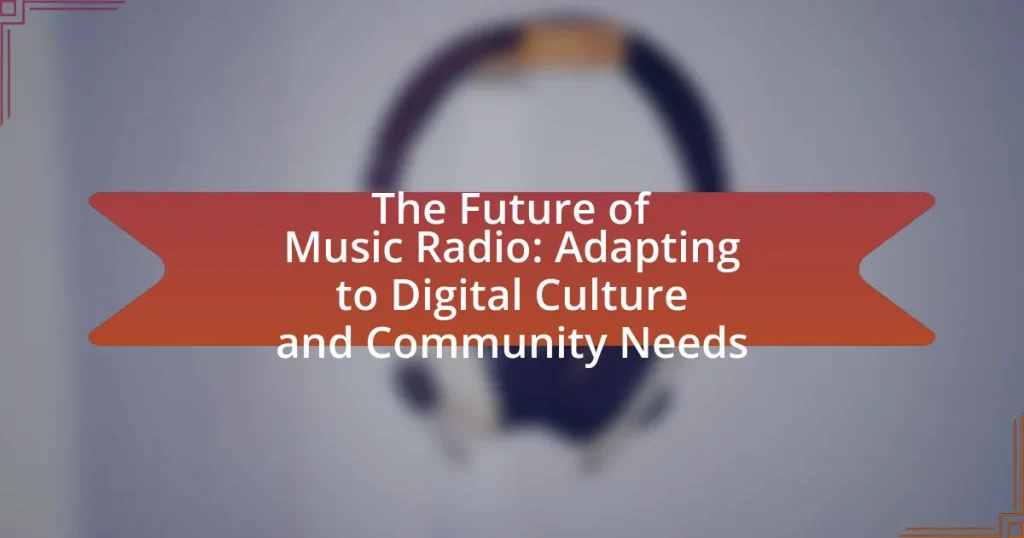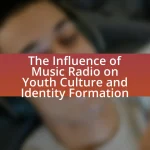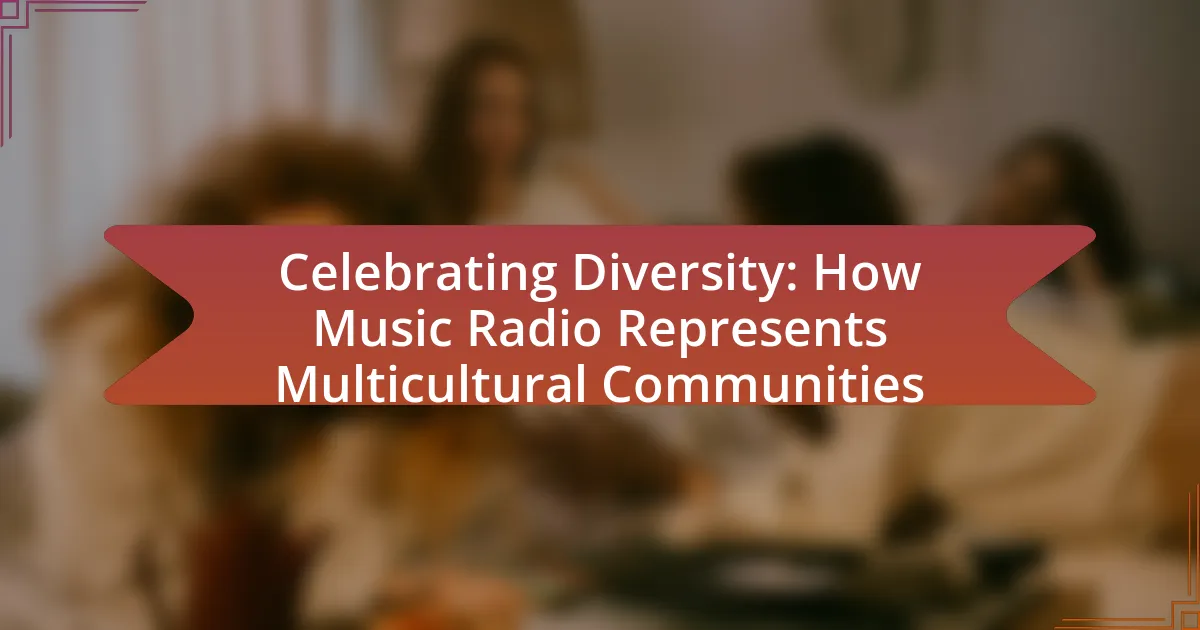The article examines the future of music radio as it adapts to the digital culture and community needs. It highlights the shift towards personalized content and community engagement, driven by technological advancements such as streaming services, digital broadcasting, and artificial intelligence. Key topics include the evolution of listener preferences, the importance of local content, and strategies for enhancing community connections. The article also addresses the challenges faced by traditional radio in competing with on-demand platforms and outlines practical steps for radio stations to remain relevant in a rapidly changing media landscape.
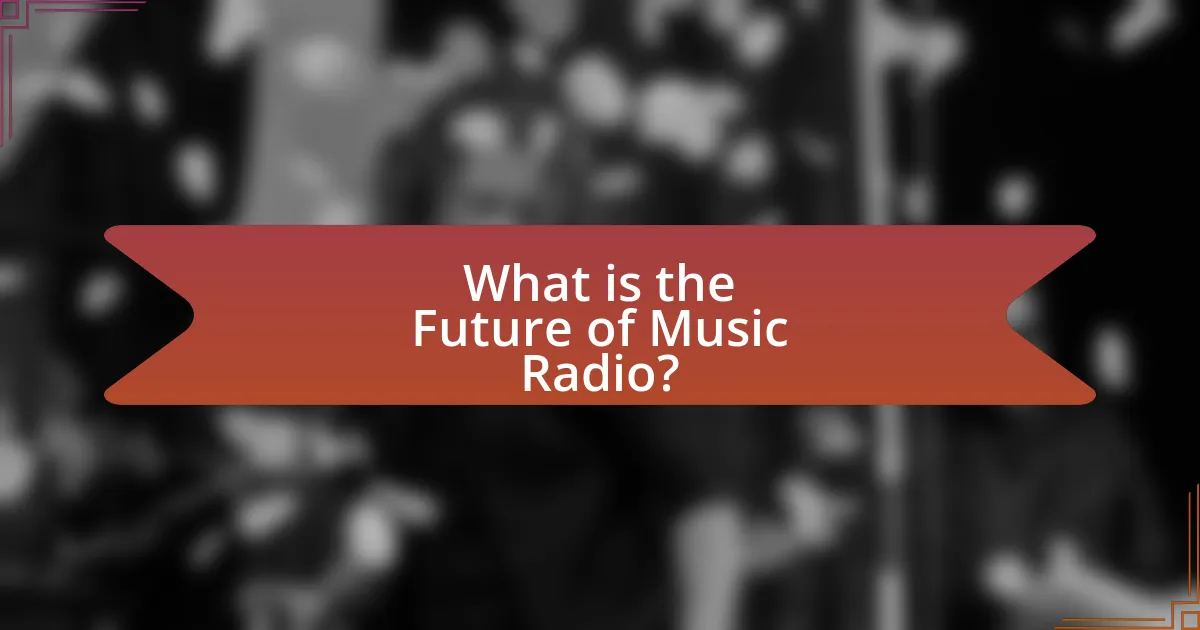
What is the Future of Music Radio?
The future of music radio is increasingly digital, focusing on personalized content and community engagement. As traditional broadcasting faces competition from streaming services and podcasts, music radio is adapting by leveraging technology to offer tailored playlists and interactive experiences. According to a 2022 report by the Pew Research Center, 61% of Americans listen to online radio, indicating a significant shift towards digital platforms. This trend suggests that music radio will continue to evolve, integrating social media and mobile applications to enhance listener interaction and foster community connections.
How is music radio evolving in the digital age?
Music radio is evolving in the digital age by integrating streaming services, personalized playlists, and on-demand content. Traditional radio stations are increasingly adopting digital platforms to reach wider audiences, utilizing apps and websites to provide listeners with access to live broadcasts and curated music selections. According to a 2022 report by Nielsen, over 60% of U.S. adults now listen to music through streaming services, indicating a significant shift in listener preferences. This evolution allows radio stations to enhance user engagement through interactive features, such as song requests and social media integration, thereby adapting to the changing landscape of digital culture and community needs.
What technological advancements are influencing music radio?
Technological advancements influencing music radio include streaming services, digital broadcasting, and artificial intelligence. Streaming services like Spotify and Apple Music have transformed how audiences access music, allowing for personalized playlists and on-demand listening. Digital broadcasting enhances sound quality and expands reach, enabling stations to broadcast online and reach global audiences. Artificial intelligence is utilized for content curation, audience analysis, and even automated DJing, improving listener engagement and operational efficiency. These advancements collectively reshape the landscape of music radio, aligning it with contemporary digital culture and community needs.
How are listener preferences changing with digital culture?
Listener preferences are shifting towards on-demand content and personalized experiences due to digital culture. This change is driven by the rise of streaming services, which allow users to curate their playlists and discover music tailored to their tastes. According to a 2021 report by the Recording Industry Association of America, streaming accounted for 83% of the U.S. music industry’s revenue, indicating a significant preference for digital consumption over traditional radio. Additionally, listeners increasingly favor platforms that offer interactive features, such as social sharing and algorithm-driven recommendations, reflecting a desire for engagement and community in their music experiences.
Why is community engagement important for music radio?
Community engagement is important for music radio because it fosters a strong connection between the station and its audience, enhancing listener loyalty and participation. Engaged communities contribute to the station’s content by providing feedback, sharing local music, and participating in events, which helps tailor programming to audience preferences. Research indicates that stations with active community involvement see increased listenership and support, as evidenced by a study from the Pew Research Center, which found that 70% of listeners prefer stations that reflect their local culture and interests. This alignment with community values not only boosts ratings but also strengthens the station’s role as a vital cultural hub.
What role does local content play in music radio’s future?
Local content is crucial for the future of music radio as it fosters community engagement and loyalty among listeners. By providing programming that reflects local culture, artists, and events, music radio stations can differentiate themselves from global streaming services, which often lack regional relevance. Research indicates that 70% of listeners prefer local content, as it creates a sense of belonging and connection to their community. Furthermore, local content can drive advertising revenue by attracting businesses that want to reach specific demographics, thereby ensuring the financial sustainability of radio stations in a competitive digital landscape.
How can music radio stations foster community connections?
Music radio stations can foster community connections by actively engaging with local audiences through tailored programming and events. By featuring local artists, hosting community events, and providing a platform for local issues, these stations create a sense of belonging and representation. For instance, research indicates that community-focused radio programming can increase listener loyalty and participation, as seen in studies conducted by the National Federation of Community Broadcasters, which highlight the positive impact of local content on community cohesion.

What challenges does music radio face in adapting to digital culture?
Music radio faces significant challenges in adapting to digital culture, primarily due to competition from streaming services and changing listener habits. The rise of platforms like Spotify and Apple Music has shifted audience preferences towards on-demand content, leading to a decline in traditional radio listenership. According to a 2021 Nielsen report, 63% of U.S. adults aged 18-34 prefer streaming services over traditional radio, highlighting the urgency for radio stations to innovate. Additionally, music radio must navigate the complexities of digital advertising, as advertisers increasingly allocate budgets to digital platforms that offer targeted marketing capabilities. This shift necessitates a reevaluation of revenue models and content strategies to retain relevance in a rapidly evolving media landscape.
How are traditional radio models being disrupted?
Traditional radio models are being disrupted by the rise of digital streaming platforms and podcasting, which offer on-demand content and personalized listening experiences. These platforms, such as Spotify and Apple Music, have significantly increased their user bases, with Spotify reporting over 500 million users as of 2023, highlighting a shift in consumer preferences towards flexibility and variety in audio content. Additionally, social media integration allows listeners to engage with content creators directly, further diminishing the traditional radio model’s relevance. This transformation is driven by technological advancements and changing audience behaviors, leading to a decline in traditional radio listenership and advertising revenue.
What impact do streaming services have on music radio?
Streaming services significantly reduce the audience and revenue of traditional music radio. As listeners increasingly turn to platforms like Spotify and Apple Music for personalized and on-demand content, radio stations face declining listener numbers. According to a 2021 report by Nielsen, streaming accounted for 83% of all music consumption in the U.S., while radio’s share dropped to 10%. This shift has forced radio stations to adapt by incorporating digital streaming options and focusing on niche programming to retain their audience.
How can music radio compete with on-demand listening options?
Music radio can compete with on-demand listening options by emphasizing live programming, community engagement, and unique content. Live programming allows radio stations to create a sense of immediacy and connection that on-demand services cannot replicate, as listeners tune in for real-time events, interviews, and music discovery. Community engagement fosters a loyal listener base through local events, contests, and listener interaction, which enhances the station’s relevance in the community. Unique content, such as exclusive interviews with artists, curated playlists by local DJs, and thematic shows, differentiates music radio from the vast libraries of on-demand platforms. According to a Nielsen report, 92% of Americans still listen to radio weekly, indicating that there is a significant audience for live, curated content that radio can leverage to maintain its competitive edge.
What strategies can music radio adopt to remain relevant?
Music radio can adopt strategies such as integrating digital platforms, enhancing listener engagement, and curating personalized content to remain relevant. By utilizing streaming services and social media, music radio can reach broader audiences and create interactive experiences. For instance, a study by the Pew Research Center indicates that 53% of Americans listen to online radio, highlighting the importance of digital integration. Additionally, hosting live events and collaborating with local artists can foster community connections, making radio stations more appealing to listeners. These strategies not only adapt to changing consumer behaviors but also leverage the growing trend of digital consumption in the music industry.
How can music radio leverage social media for audience growth?
Music radio can leverage social media for audience growth by actively engaging listeners through interactive content and targeted promotions. By utilizing platforms like Instagram, Twitter, and Facebook, music radio stations can share live updates, behind-the-scenes content, and exclusive interviews, which fosters a sense of community and encourages listener participation. For instance, a study by the Pew Research Center found that 69% of adults in the U.S. use social media, indicating a vast potential audience that can be reached through these channels. Additionally, running contests, polls, and user-generated content campaigns can enhance listener involvement and attract new audiences, as evidenced by successful campaigns from various radio stations that have seen increased engagement and listener numbers.
What innovative programming ideas can attract new listeners?
Innovative programming ideas that can attract new listeners include interactive live shows, personalized playlists, and community-driven content. Interactive live shows, such as real-time listener call-ins or social media integration, foster engagement and create a sense of community, which is essential in the digital age. Personalized playlists, driven by algorithms that analyze listener preferences, can enhance user experience and retention. Community-driven content, where local artists and listeners contribute to programming, can build a loyal audience by reflecting local culture and interests. Research indicates that radio stations that incorporate listener feedback and local content see a 30% increase in listener engagement, demonstrating the effectiveness of these innovative approaches.
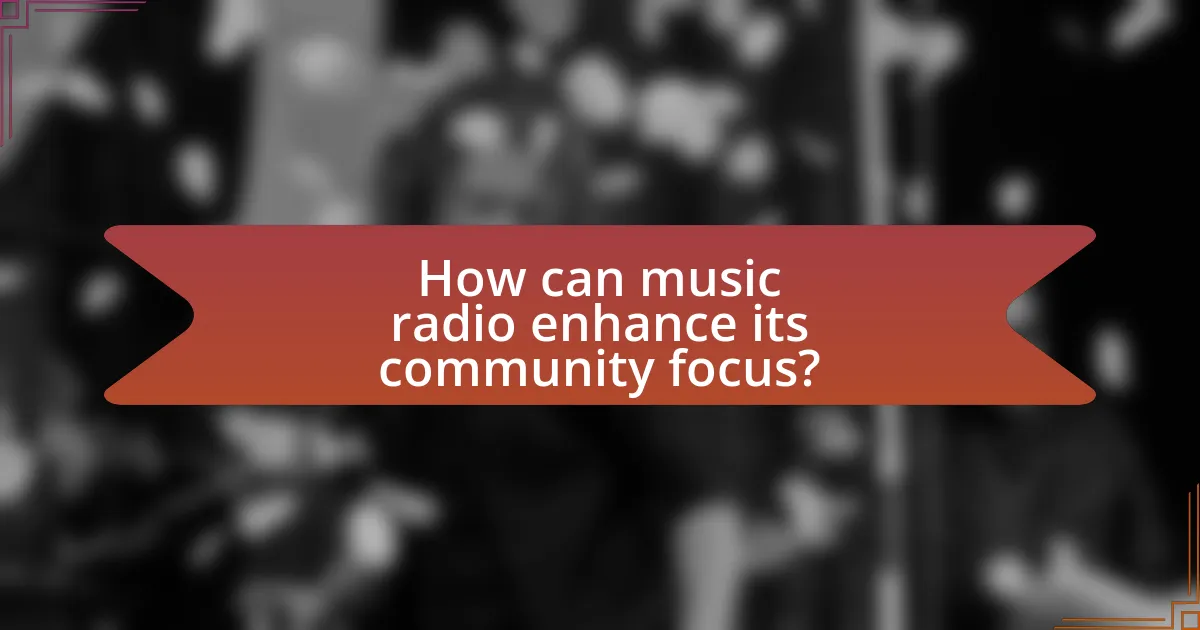
How can music radio enhance its community focus?
Music radio can enhance its community focus by actively engaging local audiences through tailored programming and community events. By featuring local artists, hosting live performances, and discussing community issues, music radio stations can foster a sense of belonging and connection among listeners. Research indicates that local content increases listener loyalty; for instance, a study by the Pew Research Center found that 70% of listeners prefer stations that reflect their community’s culture and interests. This approach not only strengthens community ties but also boosts the station’s relevance in a digital age where personalized content is crucial.
What are the best practices for local music promotion?
The best practices for local music promotion include leveraging social media platforms, engaging with local communities, and collaborating with local businesses. Social media platforms like Instagram and Facebook allow artists to reach a wider audience and interact directly with fans, which is crucial for building a loyal following. Engaging with local communities through events, open mics, and collaborations fosters relationships and increases visibility. Collaborating with local businesses, such as cafes and venues, can provide additional exposure and create mutually beneficial partnerships. These strategies are supported by studies showing that community engagement significantly boosts local artist visibility and fan engagement, leading to increased attendance at live events and higher streaming numbers.
How can music radio support local artists and events?
Music radio can support local artists and events by providing airtime for their music, promoting local gigs, and featuring interviews with artists. This exposure helps local musicians reach wider audiences, as radio remains a significant medium for music discovery; according to a Nielsen report, 93% of adults listen to radio each week. Additionally, music radio can host live events or concerts, creating platforms for local talent to perform and connect with their community, thereby fostering a vibrant local music scene.
What partnerships can music radio form to strengthen community ties?
Music radio can form partnerships with local businesses, schools, and community organizations to strengthen community ties. Collaborating with local businesses allows radio stations to promote events and services, fostering a sense of local identity and support. Partnering with schools can facilitate educational programs and youth engagement initiatives, enhancing community involvement. Additionally, working with community organizations can help address local issues and promote social causes, thereby creating a platform for community voices. These partnerships not only enhance the radio station’s relevance but also contribute to a more connected and engaged community.
What role does audience feedback play in shaping music radio’s future?
Audience feedback plays a crucial role in shaping music radio’s future by directly influencing programming decisions and content curation. As radio stations increasingly rely on digital platforms, they utilize audience insights gathered through social media, surveys, and streaming data to understand listener preferences and trends. For instance, a study by the Pew Research Center indicates that 62% of radio listeners prefer stations that adapt their playlists based on audience input, demonstrating the importance of feedback in maintaining listener engagement. This responsiveness not only helps stations tailor their offerings but also fosters a sense of community, ensuring that music radio remains relevant in a rapidly evolving digital landscape.
How can music radio effectively gather and utilize listener feedback?
Music radio can effectively gather and utilize listener feedback by implementing multiple channels for interaction, such as social media, mobile apps, and surveys. These platforms allow listeners to share their opinions in real-time, providing valuable insights into their preferences and engagement levels. For instance, a study by the Pew Research Center found that 72% of adults use social media, making it an ideal space for radio stations to solicit feedback and foster community interaction. Additionally, analyzing listener data from streaming services can help radio stations tailor their content to meet audience demands, enhancing listener satisfaction and loyalty. By actively engaging with listeners and adapting programming based on their feedback, music radio can remain relevant in the evolving digital landscape.
What tools can be used to analyze audience preferences?
Tools that can be used to analyze audience preferences include social media analytics platforms, survey tools, and web analytics software. Social media analytics platforms, such as Hootsuite and Sprout Social, allow radio stations to track engagement metrics and audience sentiment across various social media channels. Survey tools like SurveyMonkey and Google Forms enable direct feedback collection from listeners regarding their preferences and interests. Web analytics software, such as Google Analytics, provides insights into listener behavior on radio station websites, including popular content and user demographics. These tools collectively offer a comprehensive understanding of audience preferences, helping radio stations adapt to digital culture and community needs effectively.
What practical steps can music radio take to adapt to digital culture?
Music radio can adapt to digital culture by integrating streaming services and enhancing online engagement. By offering on-demand content through platforms like Spotify or Apple Music, radio stations can meet listener preferences for flexibility and accessibility. Additionally, utilizing social media for real-time interaction and audience feedback can foster community engagement, as evidenced by the rise of platforms like Instagram and Twitter where listeners actively participate in discussions. Furthermore, implementing podcasts allows radio stations to reach audiences who prefer audio content on-the-go, aligning with the growing trend of podcast consumption, which has seen a 75% increase in listenership over the past five years. These steps ensure that music radio remains relevant in a rapidly evolving digital landscape.
How can music radio implement new technologies for better engagement?
Music radio can implement new technologies for better engagement by integrating interactive platforms such as social media, mobile apps, and streaming services. These technologies allow listeners to participate in real-time polls, request songs, and engage with hosts, enhancing the overall listener experience. For instance, a study by Edison Research in 2021 found that 70% of listeners prefer stations that actively engage with them through social media, indicating that interactive engagement significantly boosts listener loyalty and satisfaction. Additionally, utilizing data analytics can help music radio stations tailor content to listener preferences, further increasing engagement.
What are the key metrics for measuring success in the digital landscape?
Key metrics for measuring success in the digital landscape include website traffic, conversion rates, engagement metrics, and return on investment (ROI). Website traffic indicates the number of visitors to a site, which can be tracked using tools like Google Analytics. Conversion rates measure the percentage of visitors who complete desired actions, such as signing up for a newsletter or making a purchase, providing insight into the effectiveness of marketing strategies. Engagement metrics, such as social media shares, likes, and comments, reflect audience interaction and content resonance. ROI quantifies the financial return on digital marketing investments, calculated by comparing net profit to the cost of the investment. These metrics collectively provide a comprehensive view of digital performance and success.
